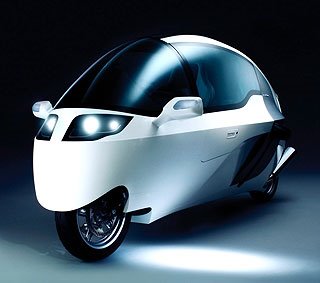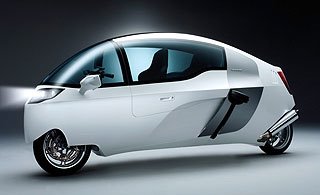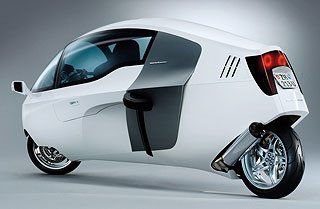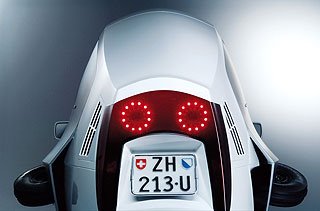2007 Peraves MonoTracer
(from Peraves Press Release) The last car on earth



 Ferry Porsche once remarked that the last car to be built on earth would surely be a sports car. By that he meant that products of limited usefulness will still be bought even when things are getting tight and that there’s no substitute for real fun – unless it’s more of the same. Driving the MonoTracer is like flying two feet off the ground. And fast, very fast indeed, if need be. But even more important for today’s drivers, “MonoTracing” within legal speed limits also has its pleasures. The world simply looks friendlier from the cockpit.
Ferry Porsche once remarked that the last car to be built on earth would surely be a sports car. By that he meant that products of limited usefulness will still be bought even when things are getting tight and that there’s no substitute for real fun – unless it’s more of the same. Driving the MonoTracer is like flying two feet off the ground. And fast, very fast indeed, if need be. But even more important for today’s drivers, “MonoTracing” within legal speed limits also has its pleasures. The world simply looks friendlier from the cockpit.
Small-series shortcomings?
We quote Porsche and talk about the 911 because we are all fans of this iconic sports car. So too are many of our clients. How many prototypes of the 911 were ever built by Porsche? Frankly, we don’t know. What we do know, however, is that we’ve built 90 MonoTracer prototypes called ECOMOBILE. They have notched up more than 12 million kilometers over the last 20 years. With 10 such vehicles we criss-crossed the USA in 1996 from Atlanta to Montana and back, 11,000 kms in 3 weeks, from the burning heat of the Arizona desert to the icy heights of the Rocky Mountains, and all without a single technical problem.
Bugs in the teeth and the Porsche 911 syndrome
We’re well aware that words alone are unlikely to convince a true biker of the advantages of cabin motorcycles; nor will they convert a dyed-in-the-wool 911 driver. Sports cars and motorcycles both have their fans, and rightly so. The only way to win them over is to belt them into the back seat of our machine and take them for a spin, taunting the cars and superbikes at every bend in the road. They will soon see the MonoTracer for what it is – the perfect combination of a sporty touring motorcycle and a real “lean machine” sports car. In short, it’s the ideal vehicle for year-round fun.
The Angle of Dangle
The best motorcycle tires for highway use on the market today allow a lean angle of about 55 degrees. Out of every 100 superbike owners in the GSX-R, Fireblade, Ninja, K1200S, R1 and 999R league maybe 20 have ever leaned their machines beyond 40 degrees. A maximum of 5 will regularly tip more than 45 degrees. And most of those sporty riders will limit their angle of lean by excessive “hanging off”, thus also limiting their speed in the curve. The MonoTracer with its “knee” (the retracted stabilizer tire) skimming the road, can lean to about 52 degrees and it has a turning circle and corner speed otherwise only achievable on a top-of-the-range sports bike. Of course, dry and clean roads are an essential requirement for such antics. If the surface is right there is no danger. And the drive is spectacular.
Expanding the concept of driving – for whom?
The MonoTracer is aimed at an international clientele and customers will obviously have to be fairly well-heeled. For their 52,500 Euros (basic price without VAT) they could also buy a Cayman, SLK or Z4, but those machines all lack the exclusivity guaranteed by an annual production of only 100 vehicles. And with the MonoTracer you also get the performance of a 911 combined with the unrivalled exhilaration of a superbike’s angles of lean thrown in for free! Many of our clients have an academic education, 911-experience, a pilot’s license and have driven or ridden the original 21 kilometre Nurburgring race track for real, not just on the Playstation. All of them are past or current motorcycle enthusiasts. Many are over 40, the age when rheumatism can start to set in. Most have to be at work on Monday, without suffering from the aches and pains of a weekend’s racing. With the MonoTracer they use the same vehicle for commuting to the office as they do for getting their kicks at the weekend.
Switzerland – Land of the MonoTracer
Nowhere will you find more radar speed traps than in the MonoTracer’s home country, here in Switzerland. The number of high-tech firms with mutually useful skills also seems to be higher than anywhere else. A mere 3000 years since the invention of the wheel and after 120 years of conventional cars and motorcycles, this environment has helped to create a third and truly different class of vehicle: the cabin motorcycle. There have been some 50 such vehicles on Switzerland’s roads for 20 years now in the form of the Ecomobile and they have become a familiar sight here. With the advent of the MonoTracer, a truly modern design of cabin two wheeler has now been added to the mix.
Design & More
For decades the first rule for excellent design has been “form follows function“. The cabin motorcycle was born with this maxim as part of its genetic make-up. For the MonoTracer rather more emphasis was placed on things like surface finish, detail workmanship, selection of materials, joint tolerances etc. so that it can bear comparison with the best models from major manufacturers of both two and four wheeled vehicles. To achieve that goal the MonoTracer has been developed with the help of suppliers to the very biggest players in the vehicle market.
Facts & Figures
Vehicle body & structure
Self-supporting composite-monocoque made from glass, kevlar and carbon weave
bonded with epoxy-resin and reinforced with strong aluminium crash and roll bars. Engine frame, steering head and stabilizer axles made from aircraft grade alloy steel. Front suspension Marzocchi 50mm USD-fork, rear Monolever shaft swingarm.
Gull-wing- door with integrated sunroof, opening to the left.
Glazing made from tinted PMMA in aviation quality.
200 liter baggage compartment
Mechanics
4 cylinder in-line BMW K-engine 1171cc, 16 valves, liquid cooling.
Dry reinforced single plate clutch. Sequential PG-gearbox with 4 forward speeds and
electrically locked reverse, shifted by push-button selector on left handlebar. Automatic clutch optional.
Reinforced BMW shaft drive. 3 x 320mm brake discs with 4-piston-hydraulic callipers, fully integrated electronic
ABS. Ceramic brake discs and brake pads, ASP anti spin control optional.
Computer-supervised electrically operated stabilizer servo system,
with a deployment time of less than half a second (Semi-automatic, hydraulically operated “softmode” system optional).
Equipment + Accessories
Contoured seats with 3-point automatic safety belts.
Interior lining in high-tech material with sound-absorbing padding.
Heating + ventilation system with ample flow and intake air filter.
Full air-conditioning optional.
GPS-RDS-4LSP-audio-system.
“Tempomat” cruise control, Bi-Xenon-lights, CD-players optional.
Operation
Motorcycle-type handlebars with extra functions. Clutch pedal, gear and stabilizer switches on left, integrated brake operation by right foot pedal, auxiliary brake lever and conventional throttle on right hand.
Technical Specifications :
Dry weight: 460-485 kgs. (1014-1069 lbs.) depending on options chosen
Maximum load: 685 kgs. (1510 lbs.)
50 liter (14 US gallon) fuel tank
Dimensions: Length = 3.65m (12 ft.), Width = 1.25 m (4 ft. 1”) with Stabilizers up, 1.40m (4 ft. 7”) with Stabilizers down, Height = 1.52m (5 ft.)
Service interval: 25,000 km / 15,000 miles or annually (whichever comes first)
Engine power output 96 kW / 130 HP at 8750 rpm, max. torque 117 Nm at 6750 rpm
Motronic-controlled injection and 3-way catalytic converter.
Acceleration 0-100 kph (0-62 mph) = 5.7 sec.
Top speed in excess of 250 kph. (155 mph)
Stopping distance: 100kph-0 = 43 meters (141 ft.)
Turning circle between walls 8.5 meters (28 ft.) Fuel consumption (ISO 7118):
4.15 liters/100km at constant 90 kph (57 mpg at constant 56 mph)
5.05 liters/100km at constant 120 kph (47 mpg at constant 75 mph)
Basic price ex factory 52,500 Euros (+ local VAT)
2 year warranty on whole machine; in addition, there is a 25 year warranty on the composite body and metal framework
© Source: article on seriouswheels
We need your comments below >>